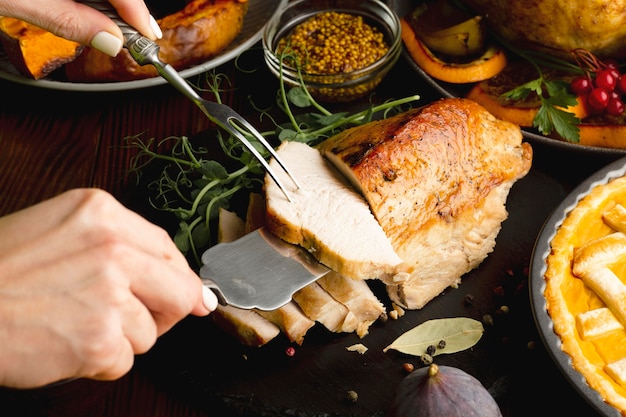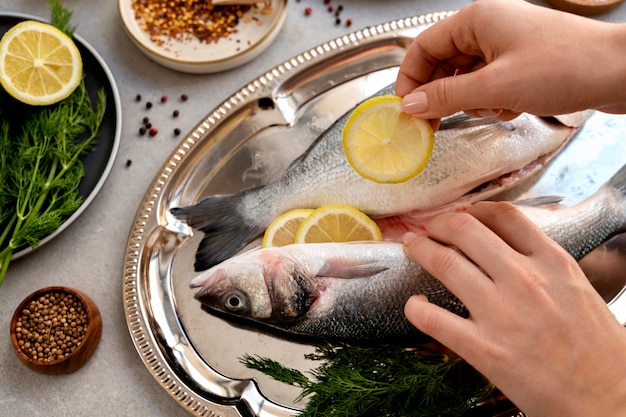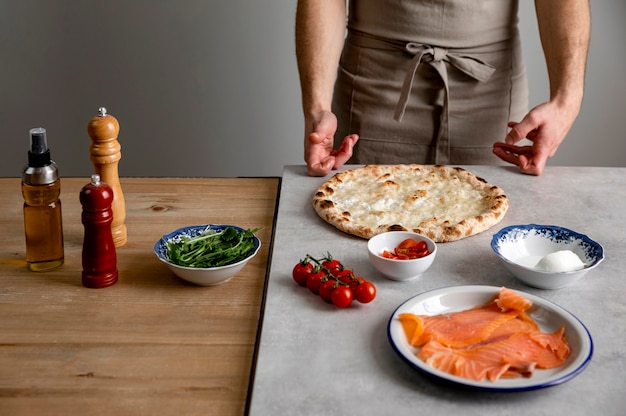(Part 1) The Importance of Getting it Right

We all know that overcooked fish is a culinary crime. It's dry, stringy, and basically inedible. I’ve been there, many times, especially with those lovely thick fillets. So, why is getting the timing right so crucial? It’s all about the delicate texture and flavour. When fish is cooked just right, it's moist, flaky, and bursts with that delicious, subtle flavour we all love. The perfect piece of fish melts in your mouth, leaving you wanting more.
(Part 2) Understanding the Fish

The first step to mastering fish cooking times is understanding the fish itself. Different types of fish cook at different rates, and they have different characteristics that need to be considered. For example, a delicate fish like flounder will cook much faster than a thick, firm fish like tuna.
2.1 Types of Fish and their Cooking Times
Here’s a quick rundown of some popular fish and their approximate cooking times. Keep in mind, these are just guidelines. The thickness of the fish and the cooking method will affect the time.
| Fish Type | Cooking Time (Minutes) | Notes |
|---|---|---|
| Salmon (fillets) | 10-15 | Best for grilling, baking, and pan-frying. |
| Cod (fillets) | 8-12 | A versatile fish that’s great for baking, poaching, and frying. |
| Haddock (fillets) | 8-12 | Similar to cod, it’s a great choice for baking and frying. |
| Tuna (steaks) | 12-15 | A firm fish that holds up well to grilling and pan-frying. |
| Sea Bass (whole) | 20-25 | A delicious fish that’s best cooked whole, either baked or roasted. |
| Trout (whole) | 15-20 | Another great choice for baking or roasting whole. |
2.2 The Importance of Thickness
The thickness of the fish is a big deal. A thin fillet will cook much faster than a thick one. So, make sure you check the thickness before you start cooking, and adjust your cooking time accordingly. For example, a thin cod fillet might only take 5-7 minutes to cook, while a thick salmon fillet might need 12-15 minutes.
2.3 Knowing the Fish’s Doneness
You’ll know your fish is cooked when it flakes easily with a fork, and the flesh is opaque and no longer translucent. Don’t worry, it’s pretty easy to tell when it’s ready. You can also use a meat thermometer to check the internal temperature. For most fish, it should reach 145°F (63°C) for safe consumption.
(Part 3) Essential Tools for Perfect Results

Okay, so you've got your fish, you know the type, and you've got a good idea of the cooking time. But, there are a few tools that will help you nail that perfect fish every time.
3.1 A Good Thermometer
Now, I know what you’re thinking - thermometers are for meat, not fish, right? Wrong! A good meat thermometer will be your best friend when it comes to cooking fish. It’s the most accurate way to ensure your fish is cooked to perfection, especially for thicker cuts, like steaks or whole fish. Just insert the thermometer into the thickest part of the fish, making sure it doesn't touch the bone, and check the temperature.
3.2 A non-stick pan
A non-stick pan is a must-have for frying and pan-searing fish. It’ll prevent sticking and make it easier to flip the fish without breaking it. A good quality non-stick pan will also ensure your fish gets a beautiful, even crust.
3.3 A Baking Sheet
Baking sheets are great for baking fish, especially if you're cooking several fillets at once. Choose a sheet with a lip to prevent any spills and make sure it’s oven-safe.
(Part 4) Cooking Methods: A Breakdown
Right, now we’re getting to the fun part - actually cooking the fish! I’ll walk you through some of the most popular methods, along with tips and tricks to make sure your fish comes out beautifully.
4.1 Grilling
Grilling fish gives it a smoky flavour and a lovely char. It’s perfect for firm fish like salmon, tuna, or swordfish.
- Preheat your grill: Make sure your grill is nice and hot before you add the fish. A hot grill will sear the fish quickly, creating a crispy crust and preventing it from drying out.
- Oil the fish: A light coating of olive oil will help prevent sticking and add flavour. Avoid using too much oil, as it can cause the fish to steam instead of grill.
- Don’t overcrowd the grill: Give your fish some space to cook evenly. If you’re grilling multiple fillets, make sure they’re not touching.
- Use a grill basket: A grill basket will make it easier to flip the fish without losing it in the flames, especially for smaller fish or delicate fillets.
4.2 Baking
Baking is a simple and foolproof way to cook fish. It's perfect for fillets, steaks, and even whole fish.
- Preheat your oven: Bake your fish in a preheated oven at 350°F (175°C). A preheated oven ensures even cooking throughout.
- Use a baking sheet: Line a baking sheet with parchment paper or foil for easy cleanup. This will prevent your fish from sticking to the baking sheet and make cleanup a breeze.
- Don't overbake: Fish cooks quickly, so don't leave it in the oven too long. Overcooked fish will be dry and rubbery.
- Baste it: For extra moisture, baste your fish with butter, oil, or lemon juice during cooking. Basting helps keep the fish moist and adds flavour.
4.3 Pan-Frying
Pan-frying is a great way to get a crispy, golden crust on your fish. It’s best for thin fillets or smaller fish.
- Use a good non-stick pan: A well-seasoned cast iron pan is perfect for pan-frying. A heavy pan will distribute heat evenly, ensuring your fish cooks evenly.
- Heat your pan: Heat your pan over medium-high heat before you add the fish. A hot pan will sear the fish quickly, creating a crispy crust.
- Don’t overcrowd the pan: Make sure your fish has space to cook evenly. If you’re pan-frying multiple fillets, cook them in batches.
- Don’t flip too soon: Let the fish cook for a few minutes on one side before flipping it. This will allow the fish to develop a crispy crust and prevent it from sticking to the pan.
4.4 Poaching
Poaching is a gentle way to cook fish, resulting in a very tender and delicate texture. It’s perfect for delicate fish like flounder or sole.
- Use a poaching liquid: A good poaching liquid is a mixture of water, white wine, and herbs. You can also add lemon juice, garlic, or other flavourings to the poaching liquid.
- Bring the liquid to a simmer: Don’t let the liquid boil. Boiling will toughen the fish.
- Add the fish: Gently place the fish in the simmering liquid. Avoid overcrowding the pot, as this will lower the temperature of the liquid.
- Cook until done: Poach the fish for a few minutes until it’s cooked through. The cooking time will depend on the thickness of the fish.
4.5 The Role of the Skin
You'll find that skin-on fish cooks up beautifully, especially when pan-fried or grilled. It adds extra flavour and prevents the flesh from drying out. But, if you prefer skinless fillets, that’s totally fine too. If you’re grilling or pan-frying skin-on fish, make sure to score the skin with a knife before cooking. This will help prevent it from curling up and make it easier to remove after cooking.
(Part 5) Tips for Perfect Fish Cooking
Okay, we’ve covered the basics, but here are some extra tips to help you avoid those cooking disasters and get that perfect fish every time.
5.1 The Importance of Resting
Don't rush to eat your fish right after it comes off the heat. Allow it to rest for a few minutes to allow the juices to redistribute, resulting in a more moist and flavourful piece of fish. This is especially important for thicker cuts of fish.
5.2 Don’t Overcrowd
Whether you're grilling, baking, or frying, don't overcrowd your pan or baking sheet. This will prevent the fish from cooking evenly, and it might even cause it to steam instead of cook properly. Give your fish some space to breathe.
5.3 Don’t Overcook
Fish cooks very quickly, so it's important not to overcook it. The best way to tell if your fish is done is to use a meat thermometer. For most fish, it should reach 145°F (63°C) for safe consumption. You can also check for doneness by flaking the fish with a fork. If it flakes easily, it’s done.
5.4 The Importance of Seasoning
Don’t underestimate the power of good seasoning. A simple sprinkle of salt and pepper can make a world of difference. You can also experiment with herbs, spices, or citrus zest to add extra flavour. For example, try adding a pinch of smoked paprika to your salmon, or a sprinkle of thyme to your cod.
5.5 Don’t Forget the Sides
Now, no fish dish is complete without the right sides. Think about complementary flavours and textures. A simple salad with a light vinaigrette, roasted vegetables, or a creamy risotto can really elevate your meal.
(Part 6) My Favourite Fish Recipes
Okay, enough about cooking times and techniques, let’s talk recipes! Here are a few of my personal favourites that always impress.
6.1 Pan-Seared salmon with Lemon and Dill
This is a classic for a reason. It's simple, elegant, and always a crowd-pleaser.
- Ingredients:
- 1 lb salmon fillet, skin on or off
- 1 tbsp olive oil
- 1 lemon, sliced
- 1/4 cup fresh dill, chopped
- Salt and pepper to taste
Instructions:
- Preheat your oven to 400°F (200°C).
- Heat the olive oil in a non-stick pan over medium-high heat.
- Season the salmon with salt and pepper.
- Place the salmon in the pan and cook for 3-4 minutes per side, or until it’s golden brown and cooked through.
- Transfer the salmon to a baking sheet.
- Top with lemon slices and dill.
- Bake for 5-7 minutes, or until the salmon is cooked through.
6.2 baked cod with Roasted Vegetables
This is a wholesome and delicious meal that’s perfect for a weeknight dinner.
- Ingredients:
- 1 lb cod fillets
- 1 tbsp olive oil
- 1 onion, chopped
- 1 red bell pepper, chopped
- 1 zucchini, chopped
- 1 yellow squash, chopped
- Salt and pepper to taste
Instructions:
- Preheat your oven to 400°F (200°C).
- Toss the vegetables with olive oil, salt, and pepper.
- Spread the vegetables in a single layer on a baking sheet.
- Place the cod fillets on top of the vegetables.
- Bake for 15-20 minutes, or until the cod is cooked through and the vegetables are tender.
6.3 Grilled tuna steaks with Mango Salsa
This is a vibrant and refreshing dish that's perfect for summer.
- Ingredients:
- 1 lb tuna steaks
- 1 ripe mango, diced
- 1/2 red onion, diced
- 1/4 cup fresh cilantro, chopped
- 2 tbsp lime juice
- 1 tbsp olive oil
- Salt and pepper to taste
Instructions:
- Preheat your grill to medium-high heat.
- Combine the mango, red onion, cilantro, lime juice, olive oil, salt, and pepper in a bowl.
- Season the tuna steaks with salt and pepper.
- Grill the tuna steaks for 3-4 minutes per side, or until cooked to your liking. For medium-rare, cook for 3 minutes per side. For medium, cook for 4 minutes per side.
- Top the tuna steaks with the mango salsa and serve immediately.
(Part 7) FAQs
Let’s face it, you’ve got questions, and I’m here to answer them.
7.1 What if my fish is overcooked?
Don’t worry, it happens to the best of us. Unfortunately, there’s no magic trick to fix overcooked fish, but you can try adding a little moisture back in. Try adding a squeeze of lemon juice or a pat of butter to help soften the texture. You can also try making the overcooked fish into a fishcake or chowder.
7.2 How do I know if my fish is done?
The best way to tell if your fish is done is to use a meat thermometer. The internal temperature should reach 145°F (63°C) for safe consumption. You can also check for doneness by flaking the fish with a fork. If it flakes easily, it’s done.
7.3 What are some good fish substitutes?
If you’re not a fan of fish, or if you have dietary restrictions, there are plenty of other protein options you can try. Chicken, shrimp, tofu, or tempeh are all great alternatives.
7.4 How do I store leftover fish?
Leftover fish should be stored in the refrigerator in an airtight container for up to 3 days. You can reheat it in the oven or microwave.
7.5 What are some tips for freezing fish?
Fish can be frozen for up to 3 months. Wrap it tightly in plastic wrap or aluminum foil and place it in a freezer-safe bag. To thaw frozen fish, place it in the refrigerator overnight.
(Part 8) Final Thoughts
So, there you have it! I hope this guide has helped you understand the ins and outs of fish cooking times, and given you the confidence to cook delicious fish meals at home. Remember, practice makes perfect, so don’t be afraid to experiment and try new things. And, most importantly, enjoy the process!
Everyone is watching

Corn on the Cob: The Ultimate Guide to Perfectly Cooked Ears
Healthy MealsAh, corn on the cob. Just the name evokes images of sunny days, barbecues, and that sweet, juicy flavour that ...

Scallops: The Ultimate Guide to Perfect Cooking
Healthy MealsAh, scallops. Those delicate, sweet, and utterly delicious morsels of the sea. They hold a special place in my...

Spaghetti Squash: The Ultimate Guide to Cooking and Serving
Healthy MealsRemember that time you saw spaghetti squash at the supermarket, looking all bumpy and strange, and thought, "W...

Salmon Cooking Times: Perfect Guide for Every Recipe
Healthy MealsLet me tell you, cooking salmon is an art form. It's all about getting that perfect balance: juicy and tender,...

Ham Cooking Time: How Long to Bake, Smoke, or Boil a Delicious Ham
Healthy MealsAh, ham. It's a classic, isn't it? A real crowd-pleaser, especially around holidays. And when done right, it'...
